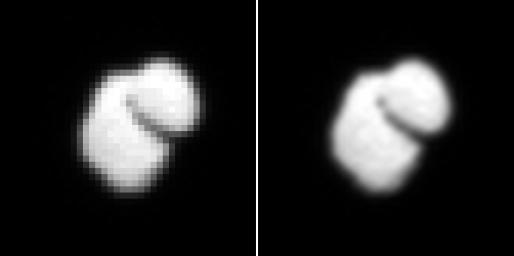
|
Rosetta Mission’s Destination: Comet 67P/Churyumov-Gerasimenko
- Click the image above for a larger view
- Full-Res JPEG (502 x 250) (6.3 kB)
- Full-Res TIFF (502 x 250) (125.8 kB)
Caption:
The Onboard Scientific Imaging System (OSIRIS) on the European Space Agency's Rosetta spacecraft photographed the mission's destination comet on July 14, 2014, from a distance of about 7,500 miles (12,000 kilometers). The observation shows that comet 67P/Churyumov-Gerasimenko has a two-part shape. The image on the left is from OSIRIS; the image on the right is enhanced with interpolated data.
Launched in 2004, the Rosetta spacecraft includes an orbiter and lander. The mission's objectives upon arrival at comet 67P/Churyumov-Gerasimenko in August 2014 are to study the celestial object up close in unprecedented detail, prepare for landing a probe on the comet's nucleus in November, and track its changes as it sweeps past the sun.
Comets are time capsules containing primitive material left over from the epoch when the sun and its planets formed. Rosetta's lander will obtain the first images taken from a comet's surface and will provide the first analysis of a comet's composition by drilling into the surface. Rosetta also will be the first spacecraft to witness at close proximity how a comet changes as it is subjected to the increasing intensity of the sun's radiation. Observations will help scientists learn more about the origin and evolution of our solar system and the role comets may have played in seeding Earth with water, and perhaps even life.
Background Info:
Rosetta is a European Space Agency mission with contributions from its member states and NASA. Rosetta's Philae lander is provided by a consortium led by the German Aerospace Center, Cologne; Max Planck Institute for Solar System Research, Gottingen; French National Space Agency, Paris; and the Italian Space Agency, Rome. JPL, a division of the California Institute of Technology, Pasadena, manages the U.S. participation in the Rosetta mission for NASA's Science Mission Directorate in Washington. Rosetta carries three NASA instruments in its 21-instrument payload.
OSIRIS was built by a consortium led by the Max Planck Institute for Solar System Research, Gottigen, Germany, in collaboration with the Center for Studies and Activities in Space, University of Padova, Italy; the Astrophysics Laboratory, Marseille, France; the Institute of Astrophysics of Andalucia, Spain; the Scientific Support Office of the European Space Agency, The Netherlands; the National Institute for Aerospace Technology, Torrejon de Ardoz, Spain; the Technical University of Madrid, Spain; the Department of Physics and Astronomy of Uppsala University, Sweden; and the Institute of Computer and Network Engineering of the Technical University, Braunschweig, Germany. OSIRIS was financially supported by the national funding agencies of the German Space Agency, Cologne, Germany; National Centre for Space Studies, Paris, France; Italian Space Agency, Rome; Ministry of Education and Science, Madrid, Spain; the Swedish National Space Board, Solna, Sweden; and the European Space Agency Technical Directorate, Paris, France.
For more information on the U.S. instruments aboard Rosetta, visit http://rosetta.jpl.nasa.gov .
For publicly released image use, see ESA's Copyright Notice Images .
Cataloging Keywords:
| Name | Value | Additional Values |
|---|---|---|
| Target | 67P/Churyumov-Gerasimenko | |
| System | Periodic Comets | |
| Target Type | Comet | |
| Mission | Rosetta | |
| Instrument Host | Rosetta Orbiter | Philae Lander |
| Host Type | Orbiter | Lander |
| Instrument | Optical, Spectrocopic and Infrared Remote Imaging System (OSIRIS) | |
| Detector | ||
| Extra Keywords | Grayscale, Infrared, Water | |
| Acquisition Date | ||
| Release Date | 2014-07-17 | |
| Date in Caption | 2014-07-14 | |
| Image Credit | Copyright: ESA/Rosetta/MPS/UPD/LAM/IAA/SSO/INTA/UPM/DASP/IDA | |
| Source | photojournal.jpl.nasa.gov/catalog/PIA18402 | |
| Identifier | PIA18402 | |
